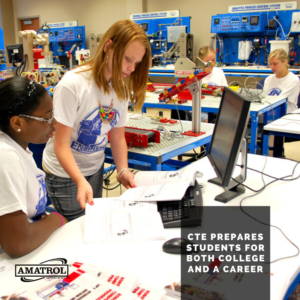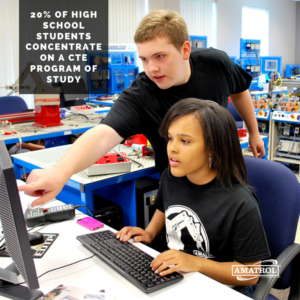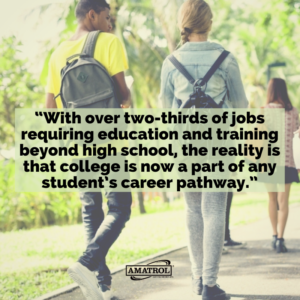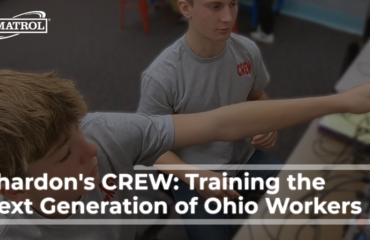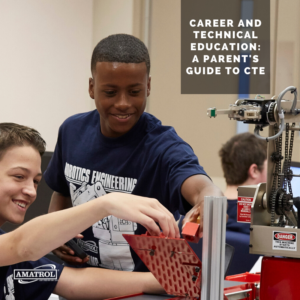
Click HERE to view Career and Technical Education: A Parent’s Guide to CTE as a multimedia presentation.
What is career and technical education (CTE)? Should my kids be taking CTE courses? What are the benefits of CTE? These are just a few of the common questions parents ask. Amatrol will provide answers and much-needed advice in this parent’s guide to CTE.
As unique and different as kids can be, parents tend to have similar hopes and dreams for their children. We want our kids to have better, easier lives than we’ve led. We want them to be good people who are happy and successful in a satisfying career.
But how do you guide your kids to a field that will offer them both job satisfaction and a sustainable living wage? More and more parents are learning that the answer to successful college and career preparation is career and technical education in high school.
What Is Career and Technical Education?
Career and technical education, commonly referred to as CTE, prepares students for both college and a career by teaching them the core academic, employability, and technical, job-specific skills they will need to pursue certifications, degrees, and high-wage careers in more than a dozen different areas.
Rather than traditional education focused mostly on concepts and theory, CTE focuses on relevant technical skills applicable to specific career pathways. CTE students gain invaluable hands-on experience that enables them to better understand and prepare for high-demand, real-world jobs.
CTE programs have developed over time and are more important than ever. In fact, Amatrol recently took an in-depth look at the evolution of modern CTE programs and their importance in creating a skilled worker pipeline: Evolving CTE Programs Can Help Bridge the Skills Gap.
Modern Career and Technical Education Has Something for Everyone
Unlike the “vocational-technical programs” or “trade schools” of the past, modern CTE programs offer students an impressive variety of choices based upon The National Career Clusters® Framework, which outlines the following 16 Career Clusters:

These 16 Career Clusters represent general fields of study that can be further broken down into 79 specific career pathways. For example, the Manufacturing Career Cluster contains six specific career pathways: Health, Safety & Environmental Assurance; Logistics & Inventory Control; Maintenance, Installation & Repair; Manufacturing Production Process Development; Production; and Quality Assurance.
While these numerous pathways don’t encompass every potential career a student might consider, they do offer fantastic opportunities for students to explore a wide variety of potential careers in all sorts of fields and industries. That’s why CTE is becoming more mainstream.
Programs of Study
Today, CTE programs serve nearly 13 million secondary and post-secondary learners. Approximately 88% of high school students take at least one CTE course, and about 20% of students concentrate on a specific career field by following an intentional sequence of CTE courses known as a program of study.
Programs of study enhance the high school experience and expand opportunities for students by allowing them the freedom to explore a variety of careers within a particular field. In this way, students can figure out what they’re good at and develop a passion for a particular career.
Following a specific sequence of courses, students receive focused academic instruction while also developing relevant technical skills. Most programs of study also feature dual enrollment opportunities, as well as realistic work experiences with actual employers.
Students completing a CTE program of study can often earn an industry-recognized certification, credential, or degree. This sets the stage for success in both college and a future career.
No Longer College vs. Career
One common misperception is that CTE is for students not bound for college. As Advance CTE notes, however, “[w]ith over two-thirds of jobs requiring education and training beyond high school, the reality is that college is now a part of any student’s career pathway.”
With Industry 4.0 driving advances in technology that are impacting workplaces across the board and around the globe, college and career are now viewed as complementary and intertwined. Modern CTE programs point students toward both. In fact, approximately 86 percent of CTE graduates pursue post-secondary education after graduation.
Of course, not all good career paths require post-secondary education. That’s why modern CTE focuses on career preparation, not just college preparation. If a particular career path calls for an industry-standard certification and an apprenticeship, modern CTE programs of study will guide students down that path toward a rewarding career with little or no college debt.
Career and Technical Education Offers Students Many Benefits
Should your kids be taking CTE courses? Today, the answer for the vast majority of students is an emphatic “Yes!” Why? Let’s take a closer look at five of the most significant benefits that modern CTE programs offer to students.
CTE Prepares Students for the Real World
“Why do I have to learn this? When will I ever use this in real life?” Has your child ever expressed similar frustration with the practicality of what they’re learning in school?
You won’t hear such complaints about CTE courses. The very nature of CTE dictates that students learn with a purpose, focusing on practical knowledge and real-world skills they’ll use on the job.
Instead of memorizing esoteric facts to pass a test, CTE students participate in hands-on training to learn relevant skills identified by real employers. These community partners can also provide mentoring and internship opportunities for CTE students, helping to ensure students are equipped with the knowledge and skills they need to succeed in the real world.
CTE Enhances the High School Experience
“Kids these days!” That’s the familiar refrain that begins many modern lamentations about the number of woefully-unprepared students leaving school with few skills and little ability to make a difference in the workplace.
That’s certainly not the case with today’s CTE students. Rigorous technical CTE coursework reinforces core academic work, leading to better-prepared, well-rounded students.
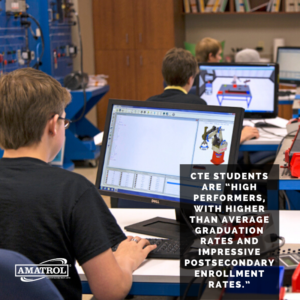 According to Advance CTE, CTE students are “high performers, with higher than average graduation rates and impressive postsecondary enrollment rates.” In fact, “[t]he graduation rate for CTE concentrators is about 95 percent, approximately 10 percentage points higher than the national average.”
According to Advance CTE, CTE students are “high performers, with higher than average graduation rates and impressive postsecondary enrollment rates.” In fact, “[t]he graduation rate for CTE concentrators is about 95 percent, approximately 10 percentage points higher than the national average.”
While those statistics should impress parents, students care more about another fact: CTE courses are fun. Today’s students are digital natives who grew up in a world full of technology. That’s why they have a natural affinity for CTE programs that focus on advanced technologies and their application in the modern workplace.
CTE Saves Families Time and Money
Have you heard the one about the art history major who racked up $80,000 in debt for a Bachelor’s degree only to graduate and work as a barista at Starbucks? Although that sounds like the beginning of a joke, it’s actually a not-so-funny reality for too many college students who amass massive debt for a degree with no clear path to a suitable career.
Today, the student loan crisis is all too real. At the same time, industries of all types struggle to fill good jobs with skilled workers. CTE programs strive to bridge the so-called “skills gap” by equipping students with the skills they need to be a productive member of the workforce as quickly as possible.
For example, students who have taken advantage of dual enrollment CTE courses often find they have a leg up on the competition, since they’ve already earned college credits for free or at greatly-reduced fees. In this way, CTE helps to reduce both the cost of college and the time it takes to complete a degree.
Moreover, CTE students who take advantage of internships, apprenticeships, and other on-the-job experiences can make money during school. Plus, students seeking to enter the workforce as quickly as possible can earn industry-standard certifications that enable them to transition seamlessly from school to career upon graduation.
 CTE Encourages Students to Find and Pursue Their Passion
CTE Encourages Students to Find and Pursue Their Passion
As parents, we want the best for our children. As they grow up, we tell them they can be anything they want to be. As high school begins, however, we must begin to focus on guiding them toward possible careers that will both satisfy their professional interests and sustain them financially.
CTE helps students figure out what they’re passionate about and good at by allowing them to explore a wide variety of career pathways. Through hands-on technical training and exposure to local employers, CTE students get a real sense of what the careers they’re interested in are actually like.
These experiences are invaluable and can motivate CTE students to explore careers they may have never considered before. Along the way, CTE students gain confidence and build leadership skills that will serve them well in the classroom and the workplace.
CTE Puts Students on the Fast Track to Success
If you could give your kids a head start on the path to a satisfying, successful career in a field they’re passionate about, would you do it? Of course you would! That’s perhaps one of the best ways to sum up what CTE courses can give your children.
The ability to explore a variety of career pathways to find their passion…the enhanced high school experience of taking fun classes that teach relevant, hands-on skills…the chance to gain real work experience at, mentoring from, and networking with actual employers…these are just a few of the opportunities that put CTE students on the fast track to college and career success.
Whatever path they choose, CTE students and their families believe they’re better prepared for the future. According to Advance CTE, “91% of parents of students in CTE believe their child is getting a leg up on their career, compared to only 44% of prospective parents.”
How Amatrol Supports Career and Technical Education
After more than three decades designing and manufacturing state-of-the-art training systems, Amatrol remains the world’s leader in skills-based, interactive technical learning. What truly sets Amatrol apart is its integration of in-depth multimedia eLearning curriculum with hands-on trainers that teach relevant skills with real-world industrial components.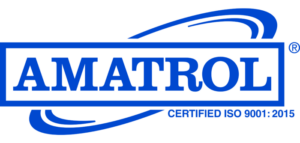
Our comprehensive learning solutions include a variety of programs perfect for high school CTE programs. Click on the links below to explore a few of Amatrol’s programs that can be implemented at your children’s school:
Additionally, Amatrol offers preparation for the following real-world industrial certification:
Want your children to have access to the best CTE programs available today? Encourage your local school administrators and CTE instructors to contact Amatrol to learn how they can leverage its technical training expertise to create a high-quality CTE program that will prepare your children for the workplace of the future.
About Duane Bolin
Duane Bolin is a former curriculum developer and education specialist. He is currently a Marketing Content Developer for Amatrol, Inc. Learn more about Amatrol and its technical training solutions, including eLearning, here and connect with Duane on Amatrol’s Twitter, Facebook, LinkedIn, and YouTube pages.


